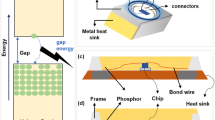Abstract
The light-emitting diodes (LED) in recent times, have become the most energy-efficient and rapidly develo** lighting technology. However, it has been found that LED contains various perilous valuable materials that make their recycling essential. It also helps to recover rare earth elements and maintains the eco-balance of the planet. The environmental and economic assessments are being carried out in this study. The CO2 emissions for recycling one tonne of LED bulbs were estimated to be in the range of 6.21 × 10–3–5.52 × 10–2 tCO2. The cost of LED bulbs recycling is estimated as Rs 20,221–20715 per tonne. The LED recycling should be promoted to reduce the cost of material processing (such as Ag, Au, As, Ga, Cu, Fe, Zn and other rare earth metals etc.), However, recycling comes at a cost of energy, process operations and manpower resources. LED bulb recycling is cost effective, eco-friendly and also helps to achieve the United Nations Sustainable Developmental Goals.
Access this chapter
Tax calculation will be finalised at checkout
Purchases are for personal use only
Similar content being viewed by others
References
Kaza S, Yao LC, Bhada-Tata P, Van Woerden F (2018) What a waste 2.0: a global snapshot of solid waste management to 2050. World Bank, Washington, DC
Biswas A, Husain D, Prakash R (2021) Life-cycle ecological footprint assessment of grid-connected rooftop solar PV system. Int J Sustain Eng 14(3):529–538. https://doi.org/10.1080/19397038.2020.1783719
Husain D, Tewari K, Sharma M, Ahmad A, Prakash R (2022). Ecological footprint of multi-silicon photovoltaic module recycling. In: Muthu SS (ed) Environmental footprints of recycled products. Environmental footprints and eco-design of products and processes. Springer, Singapore. https://doi.org/10.1007/978-981-16-8426-5_3
Nikulski JS, Ritthoff M, von Gries N (2021) The potential and limitations of critical raw material recycling: the case of LED lamps. Resources 10(4):37. https://doi.org/10.3390/resources10040037
Mizanur Rahman SM, Kim J, Lerondel G, Bouzidi Y, Nomenyo K, Clerget L (2017) Missing research focus in end-of-life management of light-emitting diode (LED) lamps. Resour Conserv Recycl 127:256–258. https://doi.org/10.1016/j.resconrec.2017.04.013
Bessho M, Shimizu K Latest trends in LED lighting. IEEJ Trans Fundam Mater 131(1):315–320. https://doi.org/10.1541/ieejfms.131.315
Statista (2021). LED penetration rate of the global lighting market based on sales from 2012 to 2030. https://www.statista.com/statistics/246030/estimated-led-penetration-of-the-global-lighting-market/
Rahman SM, Mizanur JK, Gilles L, Youcef B, Laure C (2019) Value retention options in circular economy: issues and challenges of LED lamp preprocessing. Sustainability 11(17):4723. https://doi.org/10.3390/su11174723
Ruiz-Mercado GJ, Gonzalez MA, Smith RL, Meyer DE (2017) A conceptual chemical process for the recycling of Ce, Eu, and Y from LED flat panel displays. Resour Conserv Recycl 126:42–49
Global Power GaN Market 2014: Forecasts to 2020. http://www.researchandmarkets.com/research/hphw5b/power_gan_market
Pourhossein F, Mousavi SM (2018) Enhancement of copper, nickel, and gallium recovery from LED waste by adaptation of Acidithiobacillus ferrooxidans. Waste Manag 79:98–108. https://doi.org/10.1016/j.wasman.2018.07.010
Recent data from the German National Register for Waste Electric Equipment (“Stiftung Elektro-Altgeräte Register ear”) 2016
Tumuluru JS, Heikkila DJ (2019) Biomass grinding process optimization using response surface methodology and a hybrid genetic algorithm. Bioengineering 6:12
Magna Tronix. https://www.magnatronix.in/search.html?ss=electrostatic.
Magnetic Separators. http://www.kanetec.co.jp/en/pdf/120_138.pdf
Tomas J (2004) Gravity separation of particulate solids in turbulent fluid flow. Part Sci Technol 22(2):169–187. https://doi.org/10.1080/02726350490457222
IPCC. https://www.ipcc.ch/publications_and_data/ar4/wg1/en/spmsspm-projections-of.html
Martins TR, Tanabe EH, Bertuol DA (2020) Innovative method for the recycling of end-of-life LED bulbs by mechanical processing. Resour Conserv Recycl 161:104875
Ministry of Power Central Electricity Authority, Government of India (MPCEA) (2021) CO2 baseline database for the indian power sector, user guide 2016” Accessed Nov 2021
United States Environmental Protection Agency (2020) Recycling economic information report. https://www.epa.gov/smm/recycling-economic-information-rei-report#findings
Author information
Authors and Affiliations
Corresponding author
Editor information
Editors and Affiliations
Rights and permissions
Copyright information
© 2023 The Author(s), under exclusive license to Springer Nature Singapore Pte Ltd.
About this chapter
Cite this chapter
Baig, M.S. et al. (2023). Carbon Footprint and Economic Assessment of LED Bulbs Recycling. In: Muthu, S.S. (eds) Environmental Assessment of Recycled Waste. Environmental Footprints and Eco-design of Products and Processes. Springer, Singapore. https://doi.org/10.1007/978-981-19-8323-8_3
Download citation
DOI: https://doi.org/10.1007/978-981-19-8323-8_3
Published:
Publisher Name: Springer, Singapore
Print ISBN: 978-981-19-8322-1
Online ISBN: 978-981-19-8323-8
eBook Packages: Earth and Environmental ScienceEarth and Environmental Science (R0)




